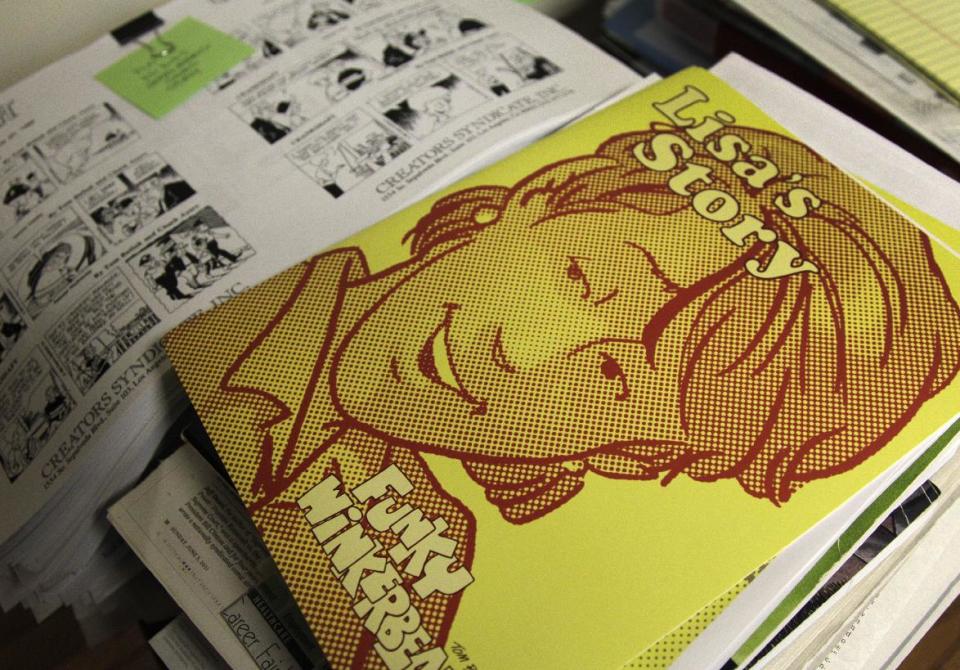Funky Winkerbean and its creator graying together
MEDINA, Ohio (AP) — Like two aging baby boomers, "Funky Winkerbean" and creator Tom Batiuk have turned gray and have experienced their share of life's ups and downs in a 40-year run on the funny pages.
Batiuk, 65, has morphed his characters over the years from mop-headed beatniks to graying 60-somethings, much like the changes for Batiuk, his hair over his collar in the 1970s but now graying and cut short.
The story lines have changed, too, from high school hijinks and awkward teen dating moments in the early years to dealing with more adult issues like alcoholism, suicide and fighting cancer. His latest hot topic story line during May: two boys who want to go to the high school prom together.
The strip debuted in more than 70 papers on March 27, 1972, and has grown to about 400. The first strip introduced the high school-age characters, including Funky ("I'm just an average kid") and Les ("I really want to be far out like Roland") and issues important to teens, including meeting a girl, getting a date and dealing with acne.
To Batiuk, delving back into the high school years with the gay prom issue underscores the generational changes and contemporary challenges his characters faced once he decided to let them begin aging along with Batiuk and the rest of us.
"I had crossed the threshold and I had grown up and the characters wanted to grow up too, it seemed like," Batiuk said in an interview in his cozy and bright studio jammed with books and mementos.
"Funky Winkerbean" might have a lower profile in mainstream culture than, say, "Doonesbury," possibly because "Funky" was a gag cartoon in the early years when society was highly politicized in the Vietnam era and has become more issue-oriented since the 1990s, said industry watcher Robert Thompson of Syracuse University.
Batiuk has taken Funky, Les and companions up the gym climbing rope in terror, through the ordeal of teen bullying, that first dating kiss and even Lisa's struggle with cancer. One paper pulled the strip during the cancer story line and complained that it wasn't funny.
Himself a cancer survivor, Batiuk said Lisa's cancer, while traumatic for a funny-page audience resistant to change, opened new opportunities for him.
"After that story, I realized that I could go forward," he said. "It sort of opened the door or me."
Such issues may depress some readers and turn away younger ones, said Charles Coletta, an instructor in pop culture at Bowling Green State University.
"He's dealing with alcoholism and people losing limbs and cancer and all at this stuff," Coletta said. "I don't think he's going to be attracting lots of younger readers with this. It's all sort of, kind of sad a little bit."
For Batiuk, though, the cartoon's ups and downs were kind of like growing up and dealing with life.
"It became more nuanced and it became more complicated," he said.
"And that's just a lot of fun. The job became more interesting. That's probably what drives it, gave me a chance to go into these more complicated, more interesting adult areas."
A strip lasting 40 years is notable but ranks behind the nearly half-century of "Peanuts" or, with some interruptions, the century-plus of the "Katzenjammer Kids," Thompson said.
The strip is a "very profitable" superstar, said Brendan Burford, comics editor at the strip's King Features Syndicate, who added that the aging of Funky has sharpened Batiuk's storytelling.
"He's been there and he's traveled that path himself. He's able to provide perspective from different generations," Burford said.
Like Baby Boomers facing wrinkles, Social Security and worse, there's no turning back for Batiuk's minions.
"That's a funny thing," he says, turning the idea over. "Once you've taken your characters to a certain point and they've experienced certain things, it sort of trivializes that experience if you go back and regress them and go back to a more childish time."
Aging opens another door for Batiuk: What happens if?
Batiuk wouldn't criticize end-of-career cartoonists who have passed their strips onto relatives or collaborators, but said he doubted he would do it.
"I haven't put anything in place like that, but I don't have an ending in mind," he said. Still, he allowed, "Occasionally you think about it."
Batiuk hinted at a possible handling of the story lines.
"When it comes time to finish Funky, I don't think anything's going to be solved, I don't think anything's going to really be resolved. It's just going to end."
Mulling over the idea, Batiuk said it would be hard for someone else to do Funky "because Funky is a very personal idiosyncratic work."
"My suspicion is when the time comes, Funky will just stop."
The 40th anniversary was marked by the publication of the start of a multi-volume complete set of the strips. The first volume has years 1972-74 and includes comments from comics chronicler Robert Harvey, who recognized Batiuk's improving artistry in those early years.
"Batiuk's drawings become somewhat crisper as he achieved greater assurance in rendering the wrinkles in clothing, for instance," Harvey said in a foreward.
"And over the years, Batiuk would become better and better at depicting his characters and telling their stories."
___
King Features Syndicate is a unit of Hearst Corp.





